News
11,650 HP producing German cargo ship: Detailed tour by former engineer
Its two-stroke crosshead engine has 9 cylinders and 3 turbochargers.
BHPian Jeroen recently shared this with other enthusiasts.
First weekend in May the harbour days in Hamburg are held. It is probably one of the largest harbour festivals in the world, certainly the largest in Europe. Hundreds of ships gather for three days in Hamburg. From German Frigates to Dutch Tugboats, vintage windjammers and so on. All the ships are open, free of charge, to the public.
Along the waterfront is a 6-kilometer-long fair, with rides and endless food and drink stalls. I had always wanted to visit these harbour days and I also wanted to go on a tour with one of the museum ships, based in Hamburg, The Cap San Diego.
So on Saturday morning, very early, around 04.30AM I pointed my W123 Mercedes star east and put the hammer down! Well, this is a 40-year-old car, so I keep it at a steady 110 km/h on the cruise control.

Almost 500 kilometers to get to my hotel in Hamburg. I reached my hotel, next to the central station around 10.30. Checked in, parked the W123 in their protected car park and headed out for the harbour.
Look at this ship. Isn’t she a beauty?
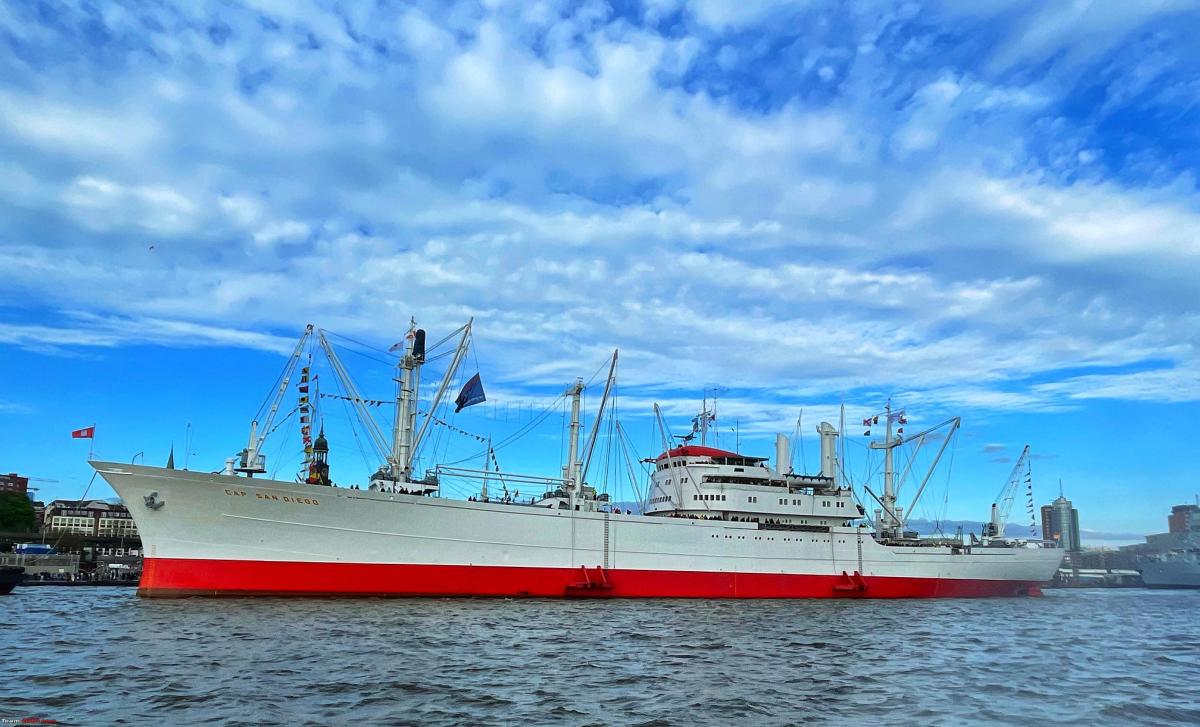
Before we start the tour a little more information on this magnificent general cargo ship. From various internet sources and the (German) brochure from the museum.
MS Cap San Diego is a general cargo ship, situated as a museum ship in Hamburg, Germany. Notable for her elegant silhouette, she was the last of a series of six ships known as the White Swans of the South Atlantic and marked the apex of German-built general cargo ships before the advent of the container ship and the decline of Germany's heavy industry. Next to (general) cargo she also carried a small number of passengers.
The Cap San Diego was built and launched by Deutsche Werft in 1961 for Hamburg Süd as the last of a series of six ships. The 159 m, 10000 dwt ship ran a regular schedule between Germany and South America, completing 120 round trips until 1981. After being sold and running under different names and under Spanish flags and also flags of convenience as a tramp trader, the run-down ship was scheduled for scrapping in 1986 when she was bought by the city of Hamburg.
The ship was restored mainly by the labour of enthusiasts and laid-off dock workers and is kept operational to date. Most of the time, the Cap San Diego is moored at the port of Hamburg where visitors can access virtually all areas of the ship from the bridge to the engine. One of the cargo holds hosts temporary exhibitions. Passenger cabins can be booked for overnight stays. Several times a year, the ship leaves the harbour on her own power for trips mostly on the river Elbe or to Cuxhaven. In 2001, the ship was awarded the Maritime Heritage Award by the World Ship Trust, and in 2003 she was declared a protected item of cultural heritage under Hamburg law.
She is powered by a MAN K9Z 140 D two stroke crosshead engine, has nine cylinders and three turbochargers. The engine produces 11650 horsepower at 118 revolutions per minute. Giving her a top speed of well over 20 knots (about 38 kilometers an hour).
She is very similar to the first ship I ever sailed on, as an apprentice engineer as part of my training; The Nedlloyd Florida. Same size, same engine power, same cargo hold configuration, age etc. So this really brings back many memories.
Just a photograph of the brochure will show you some of the details. Unfortunately, all in German. Ze Germans are still a little behind in providing their brochures, or website for that matter, in English.
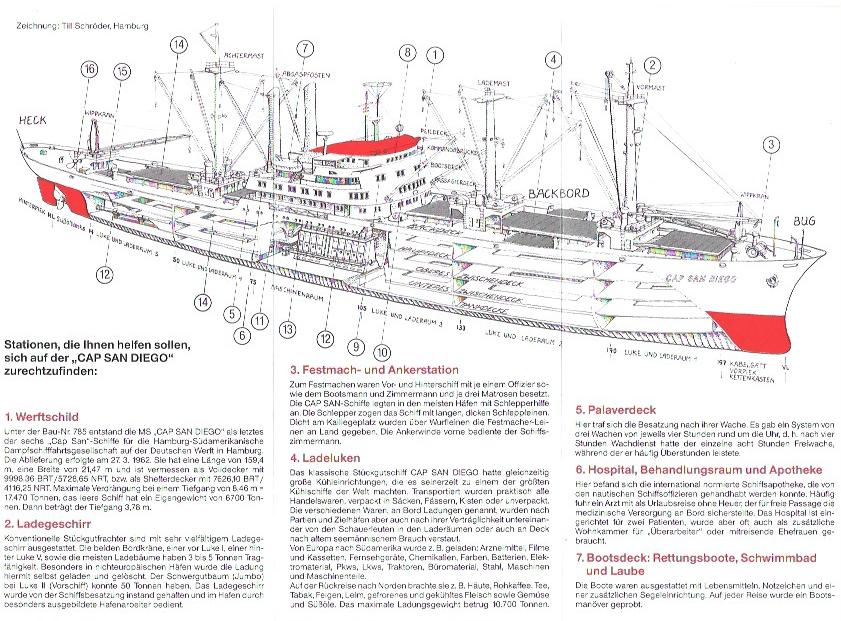
I had booked this trip many months ago and had been really looking forward to it. I spend three days in Hamburg, but the highlight of my stay was definitely sailing and touring on the Cap San Diego.
As you would expect from a former Merchant Navy Chief Engineer and nerdy techy, I will focus heavily on various technical parts of the ship. We were allowed on the ship around 12.00am with sailing scheduled for 13.00pm. First thing I did was head for the engine room, obviously!!
On most of these sorts of ships, you enter the engine room from above. There is a little platform above the main engine. It gives you a good view of the top of the engine.
You are looking at the forward four cylinder heads and two of the turbochargers. Those huge pipes going into the center of the cylinder head are the fuel lines going to the injectors.

Here we are facing aft, on the cylinder head deck. Notice the size of this engine and its component in relation to the engineer!

Just to get your perspective on the size of this main engine. Here is a little drawing that will visualise it, I hope.

This engine has a height of almost 10 meters, a length of almost 16 meters and is 4 meters wide. It weighs more than 500 tonnes!
So this is a BIG engine even by today's standards. Not as big as a modern ship's two-stroke diesels, but nevertheless, still very impressive. Let's look at some details.
Here is a close up of one of the turbochargers
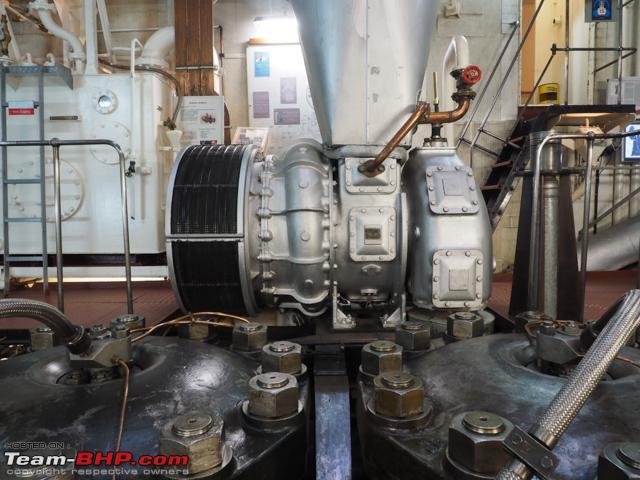
Here you see, what sits inside the turbocharger. It is one shaft with on the left a Jet turbine wheel on which the exhaust gasses are directed. On the other (right hand) end of the shaft a compressor wheel to compress inlet air for the engine.

Ships carry spares of everything. And they are bolted down all over the engine room. Here is one of the cylinder liners. You can see the scavenging airports on the side of the liner. This is a two-stroke diesel with only scavenging ports. The engine on the NedLloyd Florida has inlet ports and outlet valves. Having outlet valves instead of outlet ports allows for better airflow (scavenging) of the cylinder.
A cylinder liner like this easily weighs several tonnes. During my career, I have pulled several of these for maintenance and for repair. We had to do this once, in the middle of the ocean, with pretty heavy seas. Not an easy job, with such a huge lump of heavy metal swinging from the crane!

Each cylinder has its own cylinder head. Here you see it, with its lifting frame attached.
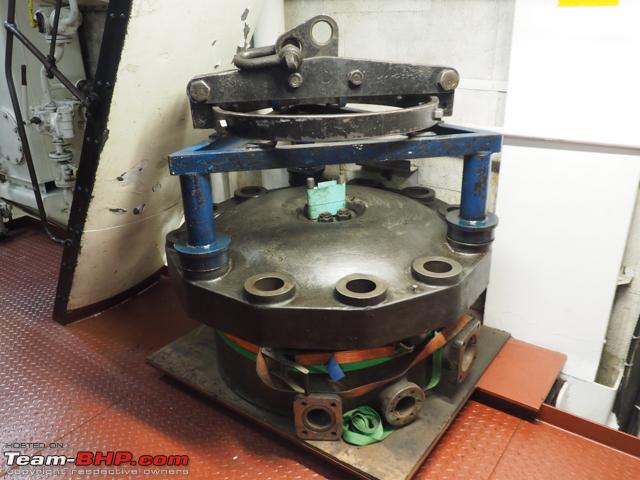
Here you see some other spare parts. Well, these would not be used as spares, the are cut-away parts to show the guests how they work.
The bit in the front is a fuel injector and behind it are some, I believe, air starter valves. They would carry a large number of fuel injectors and parts to overhaul each injector too. We would carry several sets. Overhauling an individual injector could easily take several hours. So you would pull the old injector, put a new one in and overhaul the old one later.

Let’s explore this huge engine some more. Just underneath the cylinder head deck, you will find on the port side the high fuel pressure pumps.
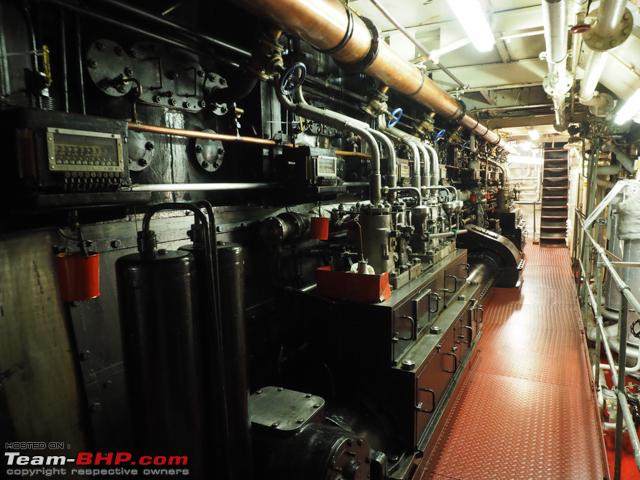
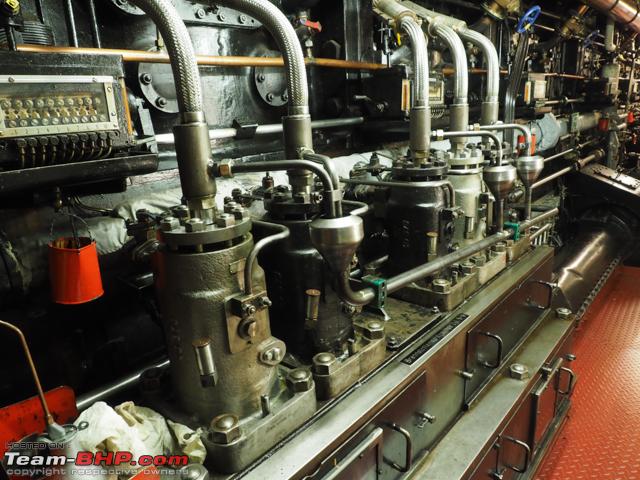
Also, the cylinder lubricators are positioned along the engine here. Each cylinder liner has a dedicated lubrication device. It was the responsibility of the duty engineer to check they were working correctly. If not, you would very quickly have some major problems. I know, I once had to fly out from home on quick notice to go a fix an engine that had run without cylinder lubrication. We had to replace all pistons and all liners!
It is driven by a crank mechanism on the right. On the left is a manual crank. Prior to the first start of the engine, the engineer and or oilers would give it a number of terms. This would ensure the cylinder liner would have some lubrication oil on its first start too.
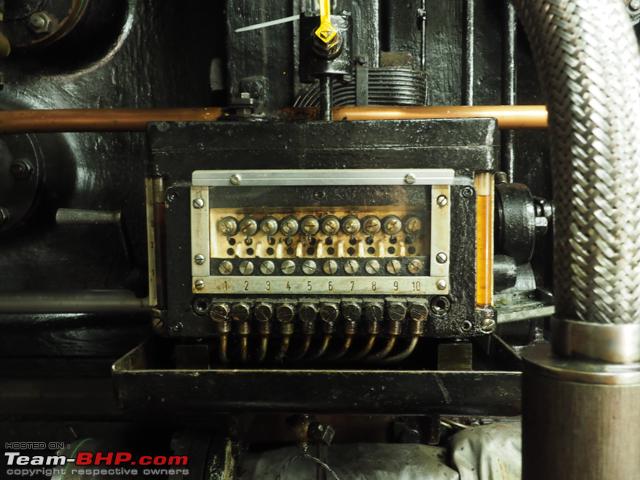
This is the manoeuvring position. These ships had manned engine rooms. The bridge would give signals to the engine room staff by means of a so-called telegraph. The engineer on duty would acknowledge the signal and start/run the engine accordingly. These large two-stroke engines are coupled directly to the propellor. They can turn two ways. So to go from ahead to astern or vice verse, the engine had to be stopped and started in the other direction. All done with these handwheels you see here.
Usually, the telegraph and the engine controls had some sort of interlocking mechanism. Just to prevent starting in the incorrect direction.
During manoeuvring there would be a number of staff in the engine room. The chief engineer and at least one duty engineer. There would be several oilers walking around too. Usually, one of them would be dedicated to keep the air pressure vessels full. These engines start by means of compressed air. So there are a couple of massive compressors to fill two huge pressure vessels up to 30 bars. No automation, you have to keep an eye on the pressure gauge and switch the compressors on/off by hand. Drain condensate etc.

Main engine control and alarm panel
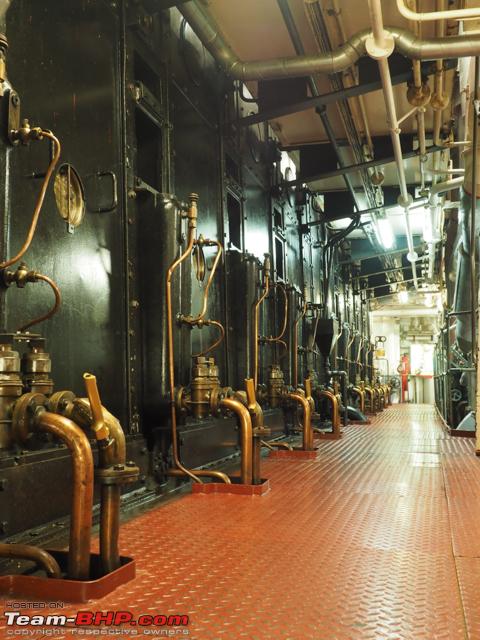
Most engine rooms are kept clean. I mean meticulously clean. But the Cap San Diego engine room gave new meaning to a clean engine room. I spend several hours in the engine room and I did not have a spot of oil on me. Not even on my hands, which keep touching the various hand rails as I go up and down endless stairs. Look at this!!! Somebody has put a lot of elbow grease into getting it to look like this!
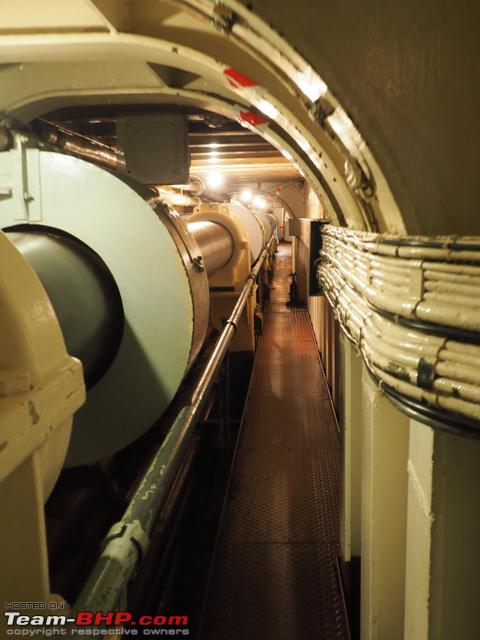
The business end of the engine. This is the propellor shaft and the, what else, so called propellor tunnel. The shaft is connected directly to the engine and the propellor. It runs, very smoothly in a number of bearings.

Apart from the main engine, an engine room is always full of all kinds of machinery and endless pipes, valves, filters and all kinds of technical stuff.
Valves and often pipe flanges are painted in different colour, so they can be easily identified. E.g. green means seawater, blue means fresh water, yellow means lubrication etc etc.



Next to the Main Engine, she also has four auxiliary engines. These are Deutz V8M 536, 500 Horsepower, 514RPM. They each drive a 310 KW generator that provides 440V/60Hz.

They had an interesting piston from one of its aux engines on display. It says (In German) this piston has run too long!!
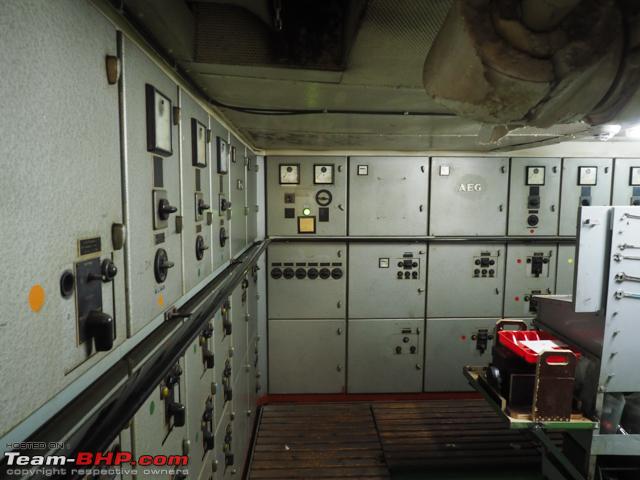
And of course various electrical panels. Most vessels have a three-phase, 440V, 60Hz system. Other power requirements (such as 220V/50 Hz) are derived from this. The reason is partly historical. When you start with 440Hz/60Hz, it is also easy to use 380V. At 60Hz electrical motors can run at higher RPM, (relatively).

Most of these sort of vessels will have a boiler for various purposes. That could be a basic as to provide heating to the cabins, or to heat (heavy) fuel, or cargo (more later). The Cap San Diego had a pretty decent boiler in the engine room.

Continue reading about Jeroen's tour for BHPian comments, insights and more information.



















